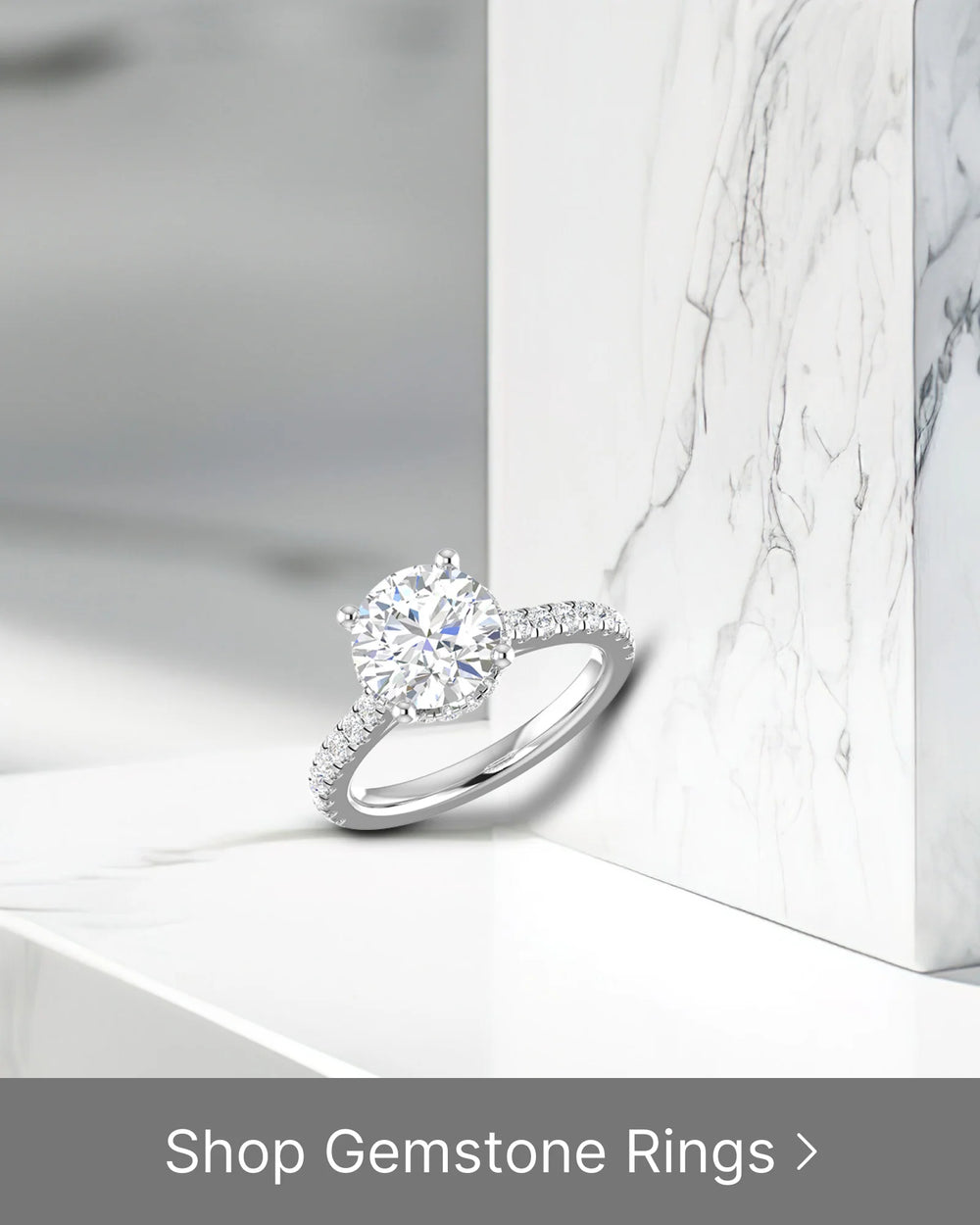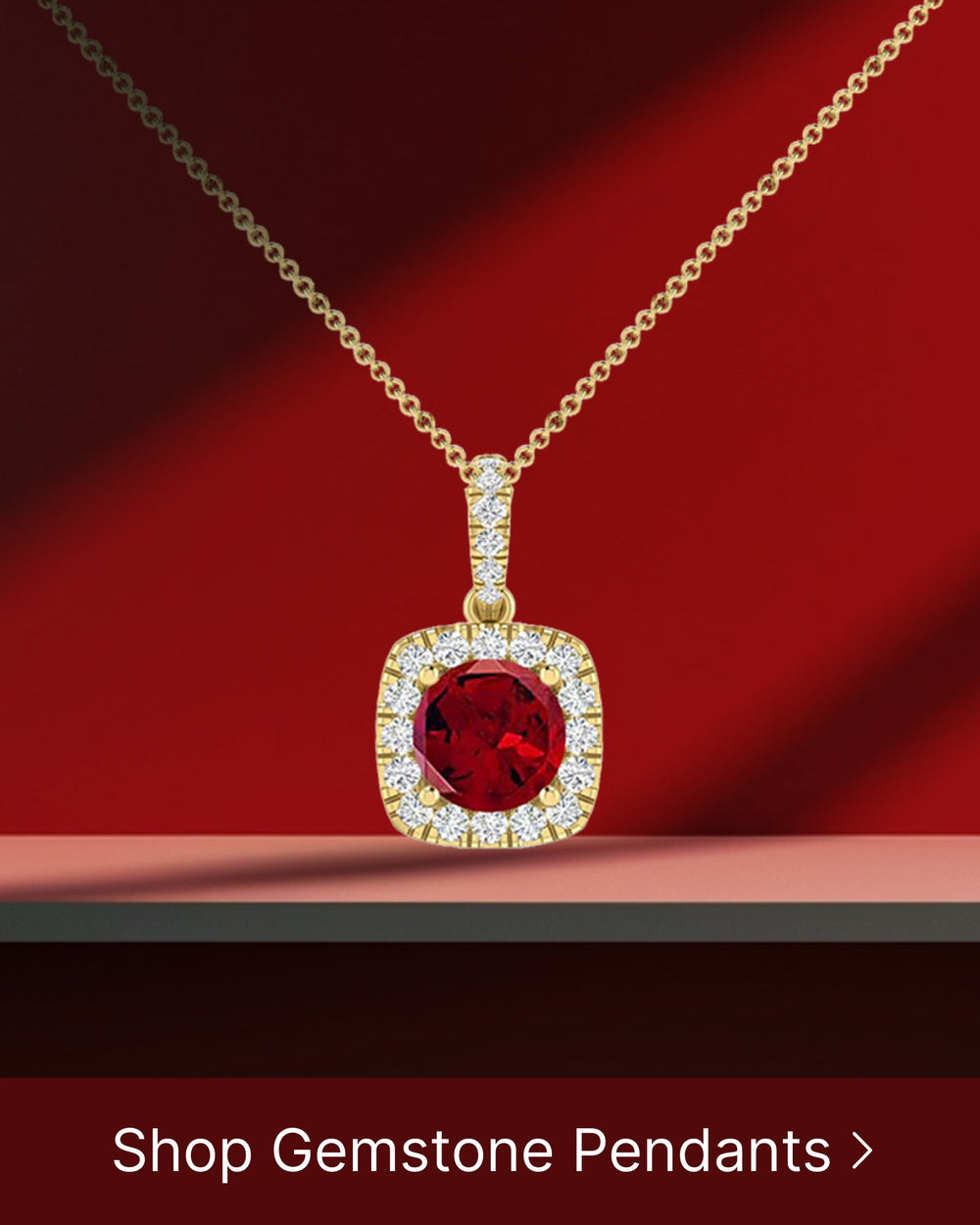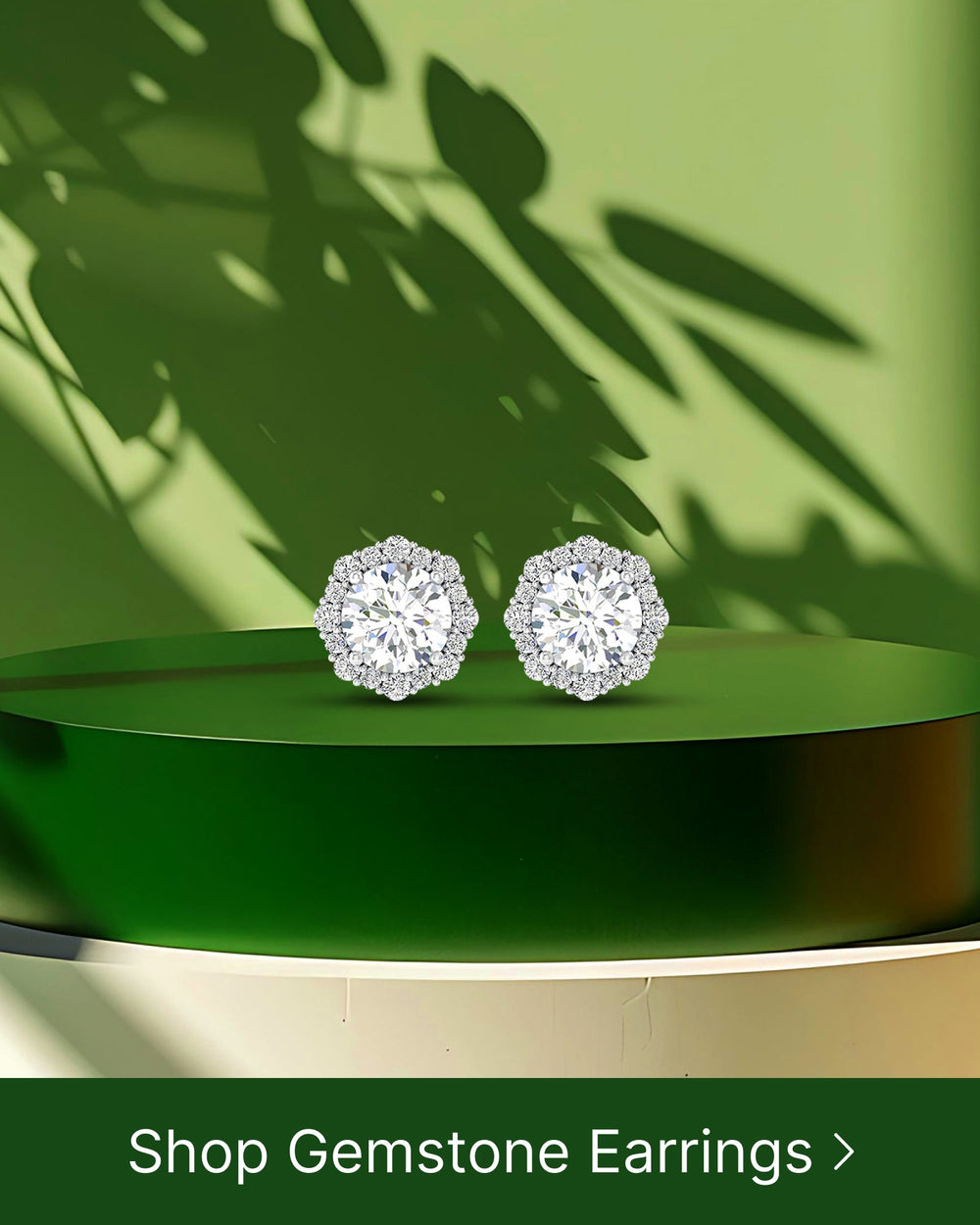Moissanite diamonds have gained popularity in recent years due to their unique characteristics and affordability compared to traditional diamonds. To truly understand the price of these stunning gems, it is essential to delve into various factors that influence their cost. This article will explore what moissanite is, its origins, how it compares to diamonds, the factors that influence its price, the pricing process, the impact of branding, and the future of moissanite pricing.
What is Moissanite?
Moissanite is a gemstone that closely resembles a diamond but is composed of silicon carbide. It was first discovered in 1893 by Henri Moissan in a meteor crater in Arizona. However, moissanite used in jewelry is lab-grown to achieve the desired quality and clarity.
When Henri Moissan stumbled upon a meteorite crater in Arizona over a century ago, little did he know that he would uncover a gemstone that would captivate the world. The discovery of moissanite was a serendipitous event that would forever change the jewelry industry.
The Origin of Moissanite
As mentioned earlier, moissanite's origins can be traced back to a meteorite that crashed into the earth. This unique occurrence gives moissanite an otherworldly allure and an intriguing backstory.
Imagine the immense force and energy that was unleashed when a meteorite collided with our planet. It is within this cataclysmic event that moissanite was formed, under intense pressure and heat. The result is a gemstone that carries the echoes of a cosmic journey, a gemstone that holds a piece of the universe within its crystalline structure.
Moissanite vs. Diamond: A Comparative Overview
While moissanite shares several similarities with diamonds, such as its brilliant sparkle and durability, there are some key differences to consider. Moissanite scores slightly lower on the Mohs scale of hardness, but it makes up for it with its exceptional fire and brilliance. Additionally, moissanite is more affordable, making it an attractive alternative for those seeking the look of a diamond without the hefty price tag.
When comparing moissanite and diamonds, it's important to acknowledge the unique qualities that each gemstone possesses. While diamonds have long been considered the epitome of luxury and status, moissanite offers a distinct allure of its own.
Moissanite's exceptional fire refers to its ability to disperse light into a spectrum of colors, creating a mesmerizing display of brilliance. This characteristic sets moissanite apart from diamonds, as it exhibits a dazzling play of light that is truly captivating.
Furthermore, moissanite's affordability opens up a world of possibilities for jewelry enthusiasts. With moissanite, one can enjoy the beauty and elegance of a diamond-like gemstone without breaking the bank. This accessibility has made moissanite a popular choice for engagement rings, wedding bands, and other fine jewelry pieces.
In conclusion, moissanite is a gemstone that not only mirrors the brilliance of a diamond but also carries a unique origin story. Its cosmic beginnings and exceptional qualities make it a captivating choice for those seeking a gemstone that is both stunning and affordable.
Factors Influencing the Price of Moissanite
When it comes to moissanite diamonds, several factors come into play in determining their price. Understanding these factors can help you make an informed decision when purchasing moissanite jewelry.
Size and Carat Weight
Similar to diamonds, the size and carat weight of a moissanite stone significantly impact its price. Larger stones require more time and resources to manufacture, resulting in higher costs. As a result, a one-carat moissanite will generally be more expensive than a smaller stone. However, it's important to note that moissanite is denser than diamonds, meaning a one-carat moissanite will appear slightly smaller than a one-carat diamond.
Additionally, the size of the moissanite stone can also affect its visual appeal. Some individuals prefer a larger stone for its bold and eye-catching presence, while others may opt for a smaller stone for a more delicate and understated look.
Quality and Clarity
Moissanite, like diamonds, is evaluated based on quality and clarity. The presence of any inclusions or blemishes can affect a stone's overall value. Stones with higher clarity ratings and minimal imperfections are generally priced higher due to their exceptional quality.
When it comes to moissanite, it's important to note that it is a lab-created gemstone. This means that the production process allows for greater control over the quality and clarity of the stone. As a result, moissanite stones often have excellent clarity and minimal imperfections, making them an attractive and affordable alternative to diamonds.
Cut and Shape
The cut and shape of a moissanite play a vital role in its beauty and overall value. A well-cut stone will exhibit maximum brilliance and fire, making it highly coveted. Different shapes, such as round, cushion, or princess, may also vary in price based on popularity and demand.
Moissanite is known for its exceptional brilliance, which is a result of its high refractive index. When a moissanite stone is cut with precision, it allows for the maximum amount of light to be reflected, creating a stunning sparkle. The most popular cut for moissanite is the round brilliant cut, which is designed to maximize the stone's brilliance and fire.
However, moissanite is available in a variety of shapes, each with its own unique appeal. Cushion-cut moissanite stones offer a vintage-inspired look with their soft, rounded corners, while princess-cut moissanite stones exude a modern and geometric elegance. The choice of cut and shape ultimately depends on personal preference and style.
By considering the size and carat weight, quality and clarity, as well as the cut and shape of a moissanite stone, you can make an informed decision when purchasing moissanite jewelry. Whether you're looking for a stunning engagement ring or a dazzling pair of earrings, moissanite offers a brilliant and affordable alternative to traditional diamonds.
The Pricing Process of Moissanite Diamonds
Understanding the pricing process of moissanite diamonds involves considering both the wholesale market and retail pricing.
Moissanite diamonds, known for their brilliance and affordability, have gained popularity as an alternative to traditional diamonds. As consumers seek more affordable options without compromising on quality, the pricing process of moissanite diamonds becomes a crucial factor in the decision-making process.
Pricing in the Wholesale Market
In the wholesale market, moissanite prices are determined by the cost of production, including labor, materials, and overhead expenses. Manufacturers carefully calculate these costs to ensure a fair pricing structure that allows them to cover their expenses and generate a reasonable profit.
Moreover, market demand plays a significant role in determining wholesale prices. If the demand for moissanite diamonds is high, manufacturers may increase their prices to capitalize on the market trend. Conversely, if the demand is low, manufacturers may lower their prices to attract buyers and maintain a competitive edge.
Another factor influencing wholesale prices is the availability of moissanite. If the supply of moissanite is limited, manufacturers may increase their prices to reflect the scarcity of the gemstone. On the other hand, if the supply is abundant, manufacturers may adjust their prices to meet the market demand and avoid excess inventory.
Jewelers who purchase moissanite directly from manufacturers can benefit from these lower wholesale prices. By cutting out middlemen and establishing direct relationships with manufacturers, jewelers can offer competitive prices to their customers while maintaining a healthy profit margin.
Retail Pricing of Moissanite
When moissanite stones reach the retail market, their prices are often marked up to cover overhead costs, marketing expenses, and profit margins. Retailers have various expenses to consider, such as rent for their physical stores, employee salaries, and marketing campaigns to attract customers.
Additionally, retailers may take into account factors such as brand reputation and exclusivity when determining the final retail price of moissanite diamonds. Established brands with a strong reputation for quality and customer satisfaction may have higher retail prices compared to lesser-known brands.
Exclusivity is another factor that can impact the retail price of moissanite diamonds. If a retailer offers a unique design or limited edition collection, they may price their moissanite diamonds higher to reflect the exclusivity and desirability of the product.
It is important to note that while moissanite diamonds are more affordable than traditional diamonds, their prices can still vary significantly depending on the retailer. Comparison shopping and conducting thorough research can help consumers find the best value for their money.
In conclusion, the pricing process of moissanite diamonds involves a careful consideration of various factors, both in the wholesale market and retail pricing. From the cost of production and market demand to overhead expenses and brand reputation, each element contributes to the final price that consumers pay for these stunning gemstones.
The Impact of Branding on Moissanite Pricing
Branding plays a significant role in the pricing of moissanite diamonds.
Premium Brands vs. Generic Moissanite
Premium moissanite brands that have built a reputation for exceptional quality and craftsmanship often command higher prices. These brands invest in innovative cutting techniques, advanced technology, and rigorous quality control measures, justifying the premium price they charge. On the other hand, generic moissanite, which lacks the brand recognition, tends to be priced more affordably.
The Role of Marketing in Pricing
The marketing strategies employed by moissanite brands also influence their pricing. Brands that invest heavily in marketing campaigns to increase consumer awareness and create a strong brand image may reflect those costs in their pricing. However, effective marketing can also create a perception of value and desirability, allowing brands to charge higher prices.
The Future of Moissanite Pricing
The price of moissanite diamonds is subject to market trends and various other factors.
Market Trends and Predictions
As consumer preferences continue to evolve, the demand for moissanite is anticipated to grow. This increased demand may lead to price fluctuations as supply adjusts to meet market needs. It is essential for both consumers and industry professionals to monitor market trends to make informed decisions.
The Influence of Synthetic Diamonds on Moissanite Pricing
The emergence of lab-grown diamonds as an ethical and affordable alternative to natural diamonds has impacted the market for moissanite. As synthetic diamonds gain popularity, it is unclear how they will influence the pricing of moissanite diamonds. Competition between these two alternatives might result in pricing adjustments.
In conclusion, understanding the price of moissanite diamonds involves considering various factors such as their origin, how they compare to diamonds, the factors that influence their price, the pricing process, the impact of branding, and the future market trends. By examining these aspects, consumers can make informed decisions and appreciate the unique value that moissanite brings to the world of gemstones.






